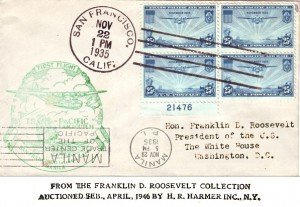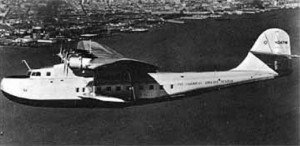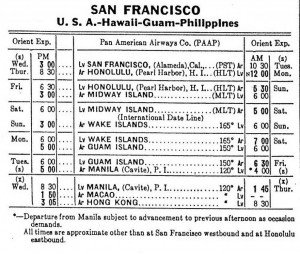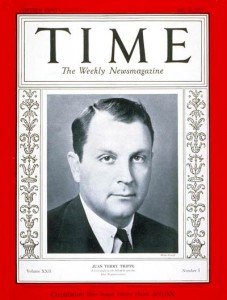Flying The Pacific Route From San Francisco to the Orient
One of the most remarkable achievements and a colorful period in early passenger plane history was the highly successful and many would say glamorous trans-Pacific route of the fabled Pan Am China Clipper. The story of the China Clipper brings back memories of a time when air travel across the Pacific was an adventure. There had never been anything like it before. At the time, it was a trip taken by the very adventurous and/or the very rich. The Pan Am China Clipper demonstrated that long distance air travel over the world’s largest ocean was indeed possible.
Thank you for reading this post, don't forget to subscribe!
The China Clipper took off from San Francisco Bay near the old Alameda Naval Air Station site in the east bay area and flew across the Pacific to Hong Kong. This was not only a great achievement but it also opened the Pacific region to much more travel.
If you think airfare is high today, a ticket on the China Clipper was in today’s dollars about $10,000.
To offer you some perspective, the price of a new home in 1935, in the middle of the Great Depression, averaged about $3,400. The average price for a new car was $625. Obviously this priced out most people. Among the very rich who could afford the airfare there were also both government travelers (not sure how this fit the national budget) and of course celebrities. Some celebrities could afford the fare but I’m sure in some cases their studio employer ended up footing the bill. This was also before the era of earning free flights with points saved up.
The Beginnings of Pan AM

The beginning of Pan Am itself was in many ways an answer to international competition in aviation. If you’ve seen the movie “The Aviator“, there is a glimpse of the Pan Am story however in the movie the plot line is really about the competition between Howard Hughes‘ Trans World Airlines and Juan Trippe‘s Pan Am. The movie is largely about the life of Howard Hughes.
International Air Route Competition
Back in the 1920’s, Germany had made headway with routes into South America. In fact, history tells us that Germany had quite a bit of interest in general with the South American continent. In 1927’s a couple of ex Army Air Corp majors got together and established an airline mostly in response to the German presence. Eventually eastern financiers entered the picture and a Yale graduate named Juan Terry Trippe in 1927 put together a holding company called the Aviation Corporation of the Americas. Between 1926 and 1930 there were many mergers and acquisitions mainly between three different investment groups. The end result was that by 1930 Juan Trippe was managing the America’s largest aviation transport company. Pan Am was a subsidiary of his parent Aviation Corp. The goal for a start up was to obtain mail contracts from the government. The other goal of course was to get landing rights.
The First Routes
Also, the presence of concrete runways in the 20’s and 30’s were hard to find. Trippe’s new company obtained rights for a mail rout between Key West Florida and Havana Cuba in 1928 and began service with a rented single engine float plane.
It was from those very humble and uncertain beginnings that Pan Am was eventually launched. Government mail contracts were the key to financing new routes. The mail contract along with landing rights put you in business.
If anything, Juan Trippe was very aggressive and lobbied for more government mail contracts. With passenger demand questionable, a mail contract was the way to have a steady predictable cash flow. Two challenges were to find air routes in which you could operate and service aircraft with suitable runways. The other was to obtain the proper aircraft.
Trippe’s spent much time trying to convince aircraft manufacturers to build larger, more powerful and longer range aircraft. Pan Am had it’s sights on service to all of the South American continent which it did accomplish. Eyes were then turned to both Europe and the Pacific region. In the early 1930’s, years before the first trans Pacific flight, Juan Trippe employed Charles Lindbergh to find a route to the Orient. Lindbergh looked at a route via Alaska and and the Aleutian Islands but this proved impossible because of the growing conflicts in China, Japan and Korea. The question then was how to build an aircraft that could travel very long distances non stop.
Two additional photo articles you’ll find interesting are the Twin Beechcraft Model 18 and the story of the Heath Parasol Homebuilt Airplane of 1929.
Speed and Comfort Island Hopping Across the Pacific Ocean
Pan Am’s answer was the Clipper fleet which eventually comprised some 28 aircraft made by three different aircraft builders. They were Sikorsky, Martin and Boeing. The Clipper that made the inaugural flight out of San Francisco bay on November 22, 1935 was a Martin M-130. This was a four engine flying boat that went on a route to Manila Bay Philippines via Pearl Harbor, Midway Island, Wake Island and Guam.

The trip took six days and a total of 60 flight hours with an average speed of 130 MPH. That first flight from San Francisco carried upwards of 100,000 mail pieces. Later, Hong Kong and New Zealand were added to the route.
The first flights carried mail only but passenger service was begun in 1936 with a one way fare of about $10,000 in today’s dollars. The Clippers could take only twelve passengers which was one reason for the high ticket price. The plane itself was appointed with a lounge which made it the most luxurious way to travel by air anyplace. Juan Trippe’s vision was to provide the same type of first class amenities one might experience on a sea voyage. Pan Am built a reputation for this kind of service.
In 1942, due to World War Two, the U.S. Government took control of the Clippers and operated mostly southeast down to Australia via Pearl Harbor and the Fiji Islands. The planes however were still crewed by Pan Am employees and were very valuable to the Pacific War effort.
In Came the Concrete Runways
The end of the Clipper airliners occurred with the build out of concrete runways throughout the world. No longer was the ability to take off and land on any large body of water a big advantage. Likewise, the aircraft manufacturers built planes for land based airports.
There is no question that the rapid rise of Pan Am was the result of obtaining large government contracts including route rights, especially in Europe, South America and the Orient. Nevertheless, the Pan Am China Clipper story is an amazing piece of history. Juan Trippe’s vision and achievement ranks at the very top of aviation history.
More Information About the History of Pan Am
A few interesting venues where you can learn about the legendary Pan American World Airways and about the Pan Am Clipper aircraft include the Museum of HistoryMiami located at 101 West Flagler Street in Miami Florida.
Another good site is the Aviation Museum at the San Francisco International Airport. Lots of good artifacts from early aviation on display there. Also in the San Francisco Bay area is the Pan Am Clipper Exhibit Hall at the Alameda Naval Air Museum in Alameda California. Make it a point to see their Clipper Aircraft flying model on display. It’s a one of a kind exhibit.
One more San Francisco Bay area venue you’ll find interesting is the Hiller Aviation Museum in San Carlos. The museum is on the grounds of the San Carlos Airport. Founded in 1998, the Hiller Aviation Museum has a memorial plaque at it’s entrance pertaining to the 1943 crash of the Philippine Clipper while approaching the San Francisco area in fog and rain. A nine man Pan Am crew in addition to ten Naval officers were killed in the crash. Among them was the commander of the Pacific Submarine Fleet.
(Article copyright Trips Into History. Photos and images in the public domain)

